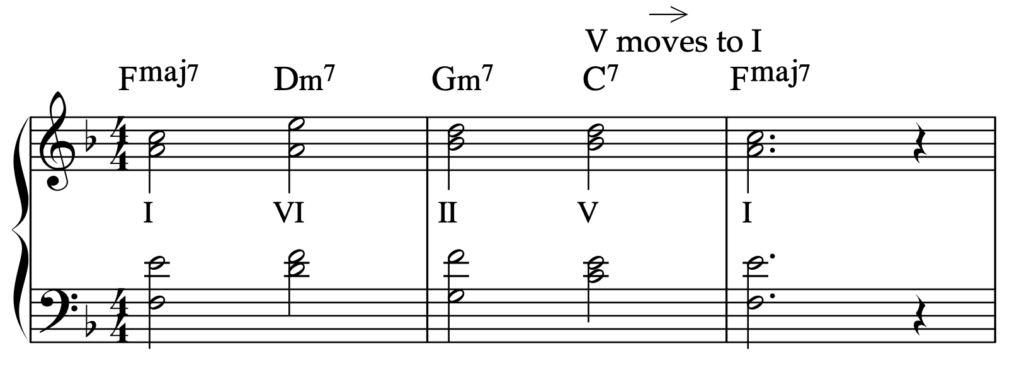The Jazz turnaround part 2
The jazz turnaround is usually a sequence of four chords that starts with the tonic chord (I) and ends with the dominant (V).
In part 1 we looked at what I describe as a pop turnaround, rather than a jazz turnaround.
The pop turnaround looks like this: I – V I – IV – V. It consists of 4 triads in the key of F.
These 4 chords in the key of F major are F, Dmin, Bb and C.
I then exchanged the IV chord for a II chord and turned the triads into 4-note chords (7ths).
The sequence now looks like this:
Fmaj7 – Dmin7 – Gmin7 – C7
Before I make another change I will say again that in a V – I situation the V ( the dominant) is the tension chord that wants to resolve to the ‘I’ chord (the tonic). And we can load this tension chord with extra notes, known as extensions and alterations.
I’m pointing this out yet again because our final chord in this turnaround, the V chord, wants to resolve to its tonic and usually does.
Here’s the turnaround sequence in F major with a tonic resolution.

To turn this into something that looks more like a jazz turnaround I’m now going to change the second chord. But before I do let’s define what constitutes a V -I sequence.
- The V of a jazz turnaround needs to be a dominant 7 chord.
- There needs to be an interval of a perfect 4th between the V and the I.
Looking at chords two and three of the above sequence the VI chord does move up to the II chord by a perfect 4th (5 half steps).
But the first chord is a minor 7 and not a dominant 7.
And so we change it from a minor 7 to a dominant 7!

Now compare the first jazz turnaround with this new one that you can see above. What are the differences?
- Chord 2 was Dmin7 and is now D7.
- I have created an altered note in both of the dominant 7 chords. Now both have a b9.
Although the overall key of this turnaround is still F, because I have created a second V-I (D7 – Gmin7) this can be regarded as a temporary key of G minor and can be treated as such.
Once again, when a dominant 7 chord is pointing towards its tonic we can load it with some extra notes, and in the above example I have introduced a b9. Now listen to the audio below and compare the first turnaround with this new version.
Notice how the D7(b9) and the C7(b9) spices things up!
As I said above, the newly created D7 leading to Gmin7 can be looked upon as a temporary key of G minor.
Therefore, when we are soloing, the G harmonic minor scale could be introduced just over this V – I.
Here’s the scale of G harmonic minor.

And here’s how it might be used when soloing over the D7 – Gmin7 section.
